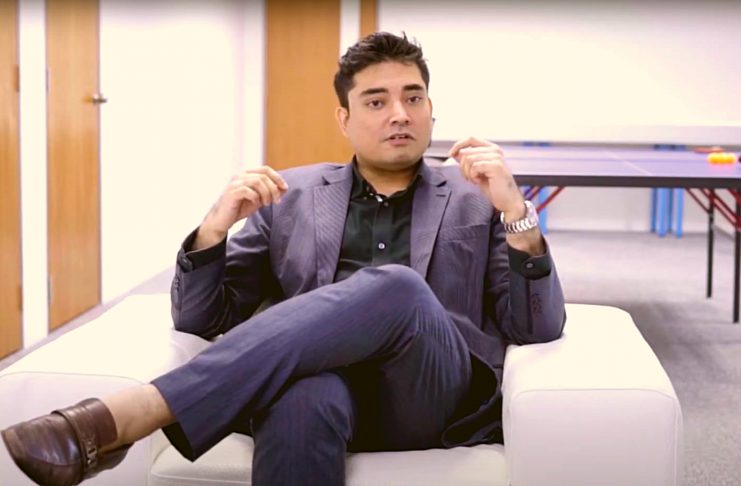Memory Magic: Learn Sancy Suraj’s Secrets!
Welcome to “Memory Magic: Learn Sancy Suraj’s Secrets!” In this article, we delve into the world of memory techniques with renowned memory expert and athlete, Sancy Suraj, who has set six memory records and has been training in memory techniques for the past 12 years. Sancy, representing Singapore at the world memory championships in 2011, has also taught over 10,000 people worldwide memory improvement techniques. In this article, Sancy shares his valuable insights on memory techniques, their applications in daily life and work, and how they can benefit individuals both personally and professionally. So, let’s unlock the secrets of memory magic with Sancy Suraj!

Can you share with us one of your most effective memory techniques that people can try for themselves?
Certainly! As a memory expert with over 12 years of experience, I have developed numerous effective memory techniques that can be easily implemented by anyone looking to improve their memory. One of my most powerful techniques is the use of mnemonic devices, which are memory aids that help encode information in a more memorable way.
One popular mnemonic device that I often teach is the “Memory Palace” technique, also known as the “Method of Loci.” This technique involves associating information with specific locations in a familiar environment, such as your home or a route you know well. By mentally placing the information you want to remember in different locations within this familiar environment, you can create a visual and spatial map that makes it easier to recall the information later.
To use the Memory Palace technique, you can start by selecting a familiar location and mentally walking through it in your mind, noting various distinctive features or landmarks along the way. Then, associate each piece of information you want to remember with a specific location or object in that environment. For example, if you’re trying to remember a list of items, you can mentally place the first item on the dining table, the second item on the sofa, and so on. When you need to recall the information, you can mentally “walk” through your Memory Palace and retrieve the associated items from each location.
Another effective memory technique that I often share is the use of vivid visualization and association. Our brains are wired to remember images and stories more easily than abstract information. By creating vivid mental images and associating them with the information you want to remember, you can make the information more memorable and easier to recall. For example, if you’re trying to remember a list of words, you can create vivid mental images of each word interacting with something else in a memorable way, such as an apple juggling oranges to remember the word “juggle.”
It’s important to note that these memory techniques require practice and repetition to become more effective over time. Regular practice and consistency are key to building a strong memory foundation. Additionally, incorporating healthy lifestyle habits such as regular physical exercise, adequate sleep, and a balanced diet can also support optimal cognitive function and enhance memory performance.
In conclusion, the Memory Palace technique and the use of vivid visualization and association are two powerful memory techniques that I often recommend to people looking to improve their memory. These techniques can be easily implemented by anyone and have been proven to be effective in enhancing memory consolidation and recall. With practice and consistency, these techniques can help individuals unlock the full potential of their memory capabilities and improve their overall cognitive performance.
What makes your memory techniques different from other memory improvement methods out there?
What sets my memory techniques apart from other memory improvement methods is the combination of my extensive experience as a memory expert and athlete, as well as my deep understanding of the fundamental principles of memory and cognitive function. My techniques are based on a holistic approach that encompasses both the physical and mental aspects of memory improvement, making them comprehensive and effective.
One key differentiating factor is the personalized and adaptable nature of my memory techniques. I understand that different individuals have unique learning styles, strengths, and weaknesses when it comes to memory. Therefore, I offer customized memory improvement programs that are tailored to the specific needs and goals of each individual. I take into consideration factors such as their learning preferences, interests, and the types of information they need to remember. This personalized approach allows me to provide memory techniques that are most effective for each individual, maximizing their potential for success.
Another differentiating factor is the practicality and applicability of my memory techniques in real-life situations. I understand that memory improvement is not just about memorizing random facts, but also about applying that information in practical settings. Therefore, my techniques focus on helping individuals improve their memory for everyday tasks, such as remembering names, numbers, important dates, and other relevant information that they encounter in their personal and professional lives. This practicality ensures that my memory techniques are not only useful in theory, but also in real-world scenarios, providing tangible benefits for individuals in their daily lives.
Furthermore, my memory techniques are grounded in scientific principles and research. As a memory expert, I stay up-to-date with the latest advancements in memory research and continuously refine my techniques based on evidence-based practices. I also draw on my own experiences as an athlete to incorporate physical exercise, nutrition, and overall well-being as important factors that can impact cognitive function and memory performance. This scientific approach ensures that my memory techniques are based on sound principles and are backed by empirical evidence, setting them apart from other memory improvement methods that may lack scientific rigor.
In conclusion, what makes my memory techniques different from other memory improvement methods is the combination of my extensive experience, personalized approach, practical applicability, and scientific grounding. My techniques are tailored to the unique needs and goals of each individual, encompass both physical and mental aspects of memory improvement, and are based on scientific principles. With these distinguishing factors, my memory techniques offer a comprehensive and effective approach to enhancing memory performance and unlocking the full potential of one’s memory capabilities.
How do you apply your memory techniques in your daily life and work?
As a memory expert and athlete, I have incorporated my memory techniques into various aspects of my daily life and work to enhance my cognitive performance and productivity. These techniques have become an integral part of my routine, helping me remember important information, stay organized, and make better decisions.
One way I apply my memory techniques in my daily life is by using them to remember names and faces. As a memory expert, I understand the importance of making connections and associations to facilitate memory retrieval. Therefore, whenever I meet new people, I actively use mnemonic techniques, such as creating vivid mental images or linking names with familiar objects or concepts, to help me remember their names. This not only helps me build better relationships by addressing people by their names, but also leaves a lasting impression, as people appreciate when their names are remembered.
In addition, I use my memory techniques to stay organized and manage my tasks effectively. I apply memory techniques to remember my to-do lists, appointments, and deadlines. For instance, I use visualization techniques to create mental images of my tasks or appointments, and associate them with specific locations or times. This helps me prioritize my tasks, stay focused, and ensure that nothing falls through the cracks.
Moreover, I apply my memory techniques in my work to improve my productivity and decision-making. For instance, I use mnemonic techniques to remember important information, such as data, facts, and figures, that I need to recall during presentations or meetings. I also use memory techniques to learn new subjects or topics efficiently, by organizing the information in a way that is easy to remember and retrieve later. These memory techniques not only help me perform better in my work tasks, but also give me a competitive edge by allowing me to access information quickly and accurately.
Furthermore, I also incorporate physical exercise, nutrition, and overall well-being as part of my memory techniques. I understand that a healthy lifestyle has a direct impact on cognitive function and memory performance. Therefore, I make sure to engage in regular physical exercise, eat a balanced diet, and prioritize adequate sleep to support optimal brain health. This holistic approach ensures that I am taking care of my physical and mental well-being, which in turn enhances my ability to apply my memory techniques effectively in my daily life and work.
In conclusion, I apply my memory techniques in my daily life and work by using them to remember names and faces, stay organized, manage tasks, and improve productivity and decision-making. I also incorporate a holistic approach to well-being, including physical exercise, nutrition, and sleep, as part of my memory techniques. By integrating these memory techniques into my routine, I am able to enhance my cognitive performance, productivity, and overall effectiveness in various aspects of my life and work.
“Memory techniques are not just tools for remembering information, but they are also keys to unlocking our full potential in life and work, by enhancing our cognitive abilities, productivity, and well-being.”
You’ve set six memory records – could you tell us a bit about how you prepared for those challenges, and what they entailed?
Preparing for memory challenges and setting records requires a combination of mental and physical training, as well as strategic preparation. As a memory expert and athlete, I have honed my skills and techniques over the past 12 years to achieve remarkable results in memory competitions.
First and foremost, mental training plays a crucial role in my preparation. I practice a variety of memory techniques, such as the Method of Loci (also known as the Memory Palace technique), mnemonic associations, and visualization, to improve my memory and cognitive abilities. These techniques allow me to encode and store vast amounts of information in my memory in a structured and organized manner, making it easier for me to retrieve and recall them during the challenges.
In addition to mental training, physical fitness is also important in memory challenges. I recognize the strong link between physical exercise and cognitive function, as exercise enhances blood flow to the brain, promotes neuroplasticity, and improves overall brain health. Therefore, I engage in regular physical exercise, such as cardiovascular workouts and strength training, to keep my body and mind in optimal condition for memory challenges.
Strategic preparation is another key element in my approach to setting memory records. I analyze the specific requirements and rules of each memory challenge, and develop customized strategies to maximize my performance. This may involve identifying patterns or categories in the information to be memorized, prioritizing certain pieces of information, or devising efficient recall techniques. I also practice extensively to fine-tune my strategies and timing, and to build my stamina and endurance for the challenges, which can be mentally and physically demanding.
Furthermore, setting memory records also requires a high level of concentration, focus, and mental resilience. I train myself to maintain a calm and focused state of mind during the challenges, while managing stress and distractions. I practice mindfulness and meditation techniques to improve my mental clarity and resilience, and to enhance my ability to stay present and fully engaged in the memory challenges.
Overall, preparing for memory challenges and setting records involves a comprehensive approach that includes mental training, physical fitness, strategic preparation, concentration, focus, and resilience. It requires consistent practice, discipline, and dedication to improve and optimize memory performance. By combining these elements in my preparation, I have been able to achieve success in setting six memory records and continue to strive for excellence in my memory feats.
How do you think memory techniques could benefit people in their personal and professional lives?
Memory techniques, when effectively applied, can bring numerous benefits to individuals in both their personal and professional lives.
In personal life, memory techniques can enhance one’s ability to remember and recall important information, such as names, dates, events, and details of daily life. This can lead to improved communication and social skills, as remembering people’s names and relevant details can build stronger relationships and create a positive impression. Memory techniques can also help in retaining and recalling personal memories, such as cherished moments and experiences, which can bring joy and nostalgia.
Moreover, memory techniques can improve learning and academic performance. By employing memory techniques to encode and store information in a structured and organized manner, individuals can more effectively retain and recall knowledge. This can lead to better grades, increased confidence in learning, and improved study habits. Memory techniques can also boost creativity and problem-solving skills, as they encourage the brain to make new connections and associations, leading to enhanced cognitive flexibility and innovation.
In professional life, memory techniques can provide a competitive advantage in various fields. For instance, in business and sales, remembering important facts, figures, and data can enhance decision-making, negotiation skills, and client relationships. In the workplace, being able to remember instructions, deadlines, and details of projects can lead to increased efficiency and productivity. Memory techniques can also benefit professionals in fields such as public speaking, presentations, and training, as they can help in memorizing key points, statistics, and anecdotes, leading to more engaging and effective communication.
Furthermore, memory techniques can improve time management and reduce stress. By effectively organizing and recalling information, individuals can better manage their schedules, appointments, and tasks, leading to improved productivity and reduced mental burden. Memory techniques can also reduce the need to rely heavily on external aids, such as notes, reminders, and electronic devices, which can alleviate stress and enhance mental clarity.
In summary, memory techniques can bring significant benefits to individuals in their personal and professional lives. From improved communication and social skills, enhanced learning and academic performance, increased productivity and efficiency, to reduced stress and improved time management, memory techniques can empower individuals to perform at their best and achieve success in various aspects of life.
“Memory techniques are the keys that unlock the doors to success, empowering individuals to retain information, increase productivity, and achieve their full potential in both personal and professional endeavors.”
Sancy’s memory techniques are unique and set apart from other memory improvement methods by their comprehensive approach. He emphasizes the importance of understanding the underlying principles of memory and optimizing lifestyle factors such as sleep, exercise, diet, and stress management to lay a solid foundation for effective memory techniques. Sancy’s techniques also emphasize the use of multiple senses, such as visualization, association, storytelling, and repetition, to encode and retrieve information, making the learning process engaging and memorable.
Furthermore, Sancy highlights the significance of organization in memory improvement. His techniques emphasize staying organized, both physically and digitally, by using calendars, to-do lists, note-taking techniques, and mnemonic devices, which aid in reducing cognitive load and enhancing memory performance. Sancy’s approach is practical, holistic, and adaptable to different learning styles and memory challenges, making it accessible and beneficial for people from all walks of life.
Sancy’s memory techniques are not limited to theoretical knowledge; he actively applies them in his daily life and work. He uses his techniques to remember names, numbers, dates, lists, and other important information, which helps him in his professional endeavors, such as public speaking, coaching, and competing in memory championships. Sancy’s practical application of memory techniques demonstrates their real-world effectiveness and relevance in various aspects of life, making them invaluable tools for personal and professional growth.

What advice would you give to someone who is struggling with memory problems, and wants to use memory techniques to improve their cognitive abilities?
If someone is struggling with memory problems and wants to use memory techniques to improve their cognitive abilities, there are several pieces of advice that I would offer:
Start with the basics: Before diving into advanced memory techniques, it’s essential to ensure that the foundational principles of memory are in place. This includes getting sufficient sleep, maintaining a healthy lifestyle with regular exercise and a balanced diet, and managing stress effectively. Taking care of these fundamental aspects of overall cognitive health can provide a solid foundation for implementing memory techniques.
Practice regularly: Like any skill, memory techniques require practice to be effective. Consistency is key. Allocate regular time for memory practice and incorporate it into your daily routine. Start with simple techniques and gradually progress to more advanced ones as you become comfortable. Practice with a variety of information, such as names, dates, numbers, and lists, to strengthen different aspects of your memory.
Use multiple senses: Memory is closely linked to our senses. Engage as many senses as possible in the process of encoding and retrieving information. For example, visualize the information, associate it with familiar objects or places, create stories or rhymes, and repeat the information out loud. This multi-sensory approach can aid in forming strong and lasting memory connections.
Stay organized: Organization is crucial for effective memory. Keep track of important information in a structured manner, such as using calendars, to-do lists, and note-taking techniques. Use mnemonic devices, such as acronyms or acrostics, to help remember complex information. Keeping your physical and digital spaces organized can also reduce cognitive load and enhance your ability to remember information.
Be patient and persistent: Improving memory takes time and effort. It’s important to be patient with yourself and not get discouraged if you don’t see immediate results. Keep practicing and refining your techniques, and celebrate small victories along the way. Remember that everyone’s memory abilities are unique, and progress may vary from person to person.
Seek professional help if needed: If you’re struggling with persistent memory problems despite using memory techniques, it may be helpful to seek professional help from a healthcare provider or a qualified memory expert. They can assess your specific situation and provide personalized guidance and recommendations to improve your cognitive abilities.
In conclusion, improving memory through memory techniques requires dedication, practice, and patience. By focusing on the basics, practicing regularly, using multiple senses, staying organized, and being persistent, individuals can enhance their cognitive abilities and unlock the potential of their memory. Remember that everyone’s journey is different, and progress may vary, so it’s important to be kind to yourself and keep striving for improvement.
“Memory techniques are like a workout for your brain – consistency and persistence are the keys to achieving cognitive strength and agility.”
In conclusion, Sancy Suraj’s memory techniques offer a holistic and practical approach to improving memory. With a focus on understanding the underlying principles of memory, using multiple senses, staying organized, and practical application in daily life and work, Sancy’s techniques are effective and relevant for individuals seeking to enhance their memory and cognitive abilities. Whether you’re a student, professional, or anyone looking to boost your memory, Sancy’s secrets of memory magic can empower you with valuable techniques to unlock the full potential of your memory. So, take a cue from Sancy Suraj and embark on your journey of memory improvement today!





